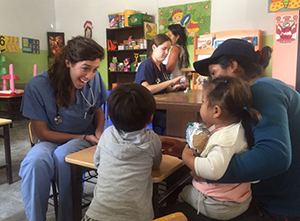
For this experience in Trujillo, Peru, the JMU PA Program partners with a company named Medical Electives. The purpose of this international clinical rotation is to provide PA students the opportunity to experience another culture & healthcare system, while also sharpening their medical Spanish skills. This experience is not recommended for students with minimal Spanish language aptitude.
While in Peru, students can expect a daily schedule similar to the following:
- 7:15am – Breakfast with host family
- 7:40am – Car ride or short walk to clinic/hospital
- 8:00am – Medical/surgical duties as assigned by the preceptor. Students can typically choose
between primary care, pediatrics, emergency medicine, or surgery - 1:00pm – Lunch with host family
- 2:30pm – Spanish classes at Medical Electives office
- 2:30-3:30 – Spanish conversation
- 3:30-4:30 – medical Spanish (anatomy, terminology, etc)
- 4:30-6:30 – Spanish grammar and vocabulary
- 6:30pm – Free time for dinner, exploring, studying, etc
In addition, every Thursday is reserved for “other activities”. These include visits to local archeological sites, cooking lessons, and/or salsa dancing. Weekends are free and on your own for exploring/studying. There are optional “Health Campaigns” available for those interested. These are mini medical mission trips setup by Medical Electives on some Saturdays.
To be eligible for this international clinical experience, one must apply through the JMU Center for Global Engagement (CGE). CGE provides support for the trip through the application process, handling of payments, and arranging for foreign travel insurance. Note that there are additional costs associated with this experience:
|
Estimated Costs for Peru Experience (optional, 4-weeks) |
|
Roundtrip flights: ~$1,000 |
|
Lodging & Medical Spanish classes: ~$2,500 |
|
Other: ~$200 |
|
Total: ~$3,700 |
What Are Our Students Saying?

"Peru was amazing. Everyone at Medical Electives was wonderfully welcoming and it was truly an incomparable learning experience. Speaking Spanish is a skill I plan to hold on to and that I think definitely helped me get a job at one of the best hospitals in the country. Overall, I would go again in a minute and recommend it to any student interested in international medicine and strengthening their medical Spanish."
– Taylor Piatkowski, class of 2016
"A typical day began with breakfast with my host family. Then at a local hospital, I would round with Peruvian medical students, often in trauma rooms. I was also able to participate with primary care and in multiple surgeries with the attending physician. It is incredible what the Peruvians are able to do given the limitations of their operating budget. I spent the afternoons with amazing teachers for four hours of Spanish conversation, grammar, and medical vocabulary. The class size was small and consisted of myself, two other Americans, and three medical students from Australia, New Zealand and the UK. The classes were very well conducted and I feel that I am much better able to communicate with Spanish speaking people here now because of it."
– Tyler Prewett, class of 2015
"The Peru rotation is an incredible experience. I can't think of a better opportunity to practice medicine in a community hospital, study Spanish, and live with a local family. I can say with confidence that by the end of my time there I could provide diagnosis and treatment in Spanish, and I know I will carry this skill to wherever I end up. Highly valuable experience. I wish I could do it again."
-Elise Shellenberger, class of 2016
Fun Facts about Peru
- The principle language of Peru is Spanish, but there are 43 native dialects spoken in the Amazon communities and the Quechua and Andean regions
- Trujillo is home to about 1 million people making it the 2nd largest city in Peru (after the capital, Lima)
- Trujillo is home to four medical schools
- Huanchaco (small coastal town next to Trujillo) is considered the birthplace of surfing.

